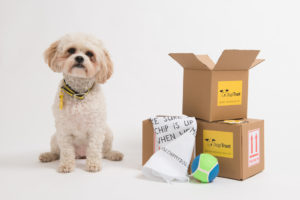Moving VIPs (Very Important Pets)

Americans love their pets – and that love is getting stronger. According to 2015-2016 statistics, nearly 80 million U.S. homes had something furry, finny, feathery or leathery sharing their living space, a figure that has increased nearly 10 percent since 1988. In addition, the number of people who consider their pets part of the family has grown in size and effort, with dog and cat birthday parties and professional portraits becoming more commonplace every day.
Thus, for many people changing location, there’s one more family member to think about when making the transition to a new home. If you are among those pet fanciers, here are a few things we like to remind clients to consider and do to reduce the stress of the move on these VIPs (very important pets), with a focus on dogs and cats.
- First, keep them out of the way of movers. Perhaps far away, as in a kennel or at someone else’s home. This may see like a no-brainer, but you can get so used to having a pet around, you can forget others aren’t. This is especially true for dogs and cats that don’t react or interact well to strangers.
- Keep all their essentials with you. From familiar food to favorite toys, sameness can ease the stress. Also try to keep schedules and routines as close to the same as possible. Once you’ve moved, remember this is new territory for them, as well, and having the same bed, blanket, crate or bowl around can help in the adjustment. That said, things that should change with the new location are tags and microchips to update contact information.
- Remember that cats and dogs are as different as, well, cats and dogs. While dogs typically are more free-range and exploratory, cats like the status quo and don’t deal well with change or disruption. So, like your children, each may have different responses to the move, according to animal science experts. This site has some great tips for making the physical move easier on your animal companions, including one most people don’t think about: keeping a current health certificate at hand during interstate travel.
- Once you arrive, leave the pets where they are until you check the house carefully for potential hazards. While most experts advise not to give your animals free rein until after all your boxes unpacked and your furniture is in place, this may not be possible. In this case, the best you can do may be segregating the boxes in one room while you gradually unpack them and your pets check out their new territory.
- Check with a pet store or veterinarian when moving other types of animals who may not be as hardy or adaptable as typical animal friends, especially when transporting exotics.
- Be aware that a full adjustment could take some time, with your companions acting out in strange ways. Since many animals react to their human companions’ moods, it can help if you keep everything low-key. Not working so well? You can check with a dog trainer or local vet on ways in which to accelerate your pets’ comfort levels in new surroundings.
- Don’t let them get lost in the shuffle. If they need, and are used to getting, attention and/or affection, don’t slack off during this important transition period.
Relocating with animals is not easy, but, for most pet owners, there is no other option. Therefore, like the rest of the moving process, it will pay to do the research and planning required to get them safely to their new residence and quickly at home there.
We hope this blog helped you along the way and encourage you to contact us today to learn more about Yarnall and our services.




Leave a Reply